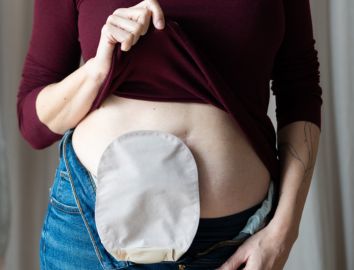Types of Stoma

The type of ostomy bag used depends on the type of stoma you have, which can be either a colostomy, ileostomy or urostomy.
For some colostomy or ileostomy patients, the stoma may be temporary to allow time for the bowel to heal before the stoma is reversed. The length of time required before reversal depends on individual circumstances.
What types of stomas are there?
Colostomy
A Colostomy is created during an operation to bring part of the large bowel or colon through an opening in the abdomen. This allows for the passage of faeces and wind from the body into a bag/pouch instead of through your anus.
A Colostomy is usually positioned on the left side of your abdomen, but your surgeon may need to put it on the other side. Your Stoma Specialist Nurse will help you find the best position for your stoma before your operation. She will mark your tummy as a guide for your surgeon. A Colostomy may be permanent or temporary and can be formed for different reasons.
Your surgeon and Stoma Specialist Nurse will explain this to you before your operation.
A Colostomy can be an end Colostomy or a loop Colostomy. A closed, one-piece, or two-piece bag is used to collect the output from the Colostomy. The output is usually soft, semi-formed, or formed. Some people have loose output from their Colostomy and may need a drainable bag; this will be required in the first few days after stoma surgery. Your Stoma Specialist Nurse will help you to choose the best stoma bag for your needs.
Ileostomy
An ileostomy is made from the small intestine (Ileum) and is created during an operation to bring part of the small bowel through an opening in the abdomen. It is usually it will be located on the lower right-hand side of the abdomen. The Ileostomy allows for faeces and wind to pass through an opening in the abdomen instead of the anus and is created for a number of reasons
An Ileostomy may be temporary or permanent, and the output can vary from watery to porridge-like or more like toothpaste and can be corrosive due to the presence of digestive enzymes. A drainable, one-piece, or two-piece bag is required to contain the Ileostomy output. The drainable bag can be left on for 1-3 days and must be emptied as needed.
Your Stoma Specialist Nurse will help you choose the best stoma bag for your specific needs.
Urostomy
A Urostomy is a diversion which drains urine and is made using the small bowel. It is generally located on the abdomen on the lower right-hand side. The output may contain mucus as a portion of the small bowel is used to form the stoma.
Stomas can be permanent or temporary, depending on the reason for creating them. You may have a temporary stoma for just a month or it may be 2 or 3 years. A temporary stoma is often a loop or double-barrel stoma which has two openings and any output will emerge from the largest one.
A permanent stoma is constructed if it is unlikely that the portions of the digestive segments can be rejoined or in the case of a Urostomy. Permanent stomas are usually end stomas (not loop) and only have one opening.
What is a temporary stoma?
Sometimes, a stoma is only needed temporarily to help the body recover from surgery or an injury. In this case, a temporary stoma is created to allow the affected area to heal without added strain. A temporary stoma can be reversed. It can be a loop or an end stoma.
Stoma reversal surgery can be performed. It involves surgically joining the piece of bowel back together, allowing the body to work as before. How long a temporary stoma stays in place varies from one individual to the next; this is discussed and planned with the surgical team. Once your stoma has been reversed, your bowel function may be different from what it was previously, but this depends on the type of operation you had. Your Surgeon and Stoma Specialist nurse will explain what to expect.
Stoma reversal surgery may not be for everyone and some people do opt to remain with their stoma.
How should a stoma look?
A healthy stoma should be red in colour similar to the inside of the mouth; this is due to the rich blood supply to the stoma. If the colour of the stoma changes, turns pale, dusky or darker then please contact your stoma nurse.
You may find that your stoma bleeds when wiped, this is normal and is again due to the rich blood supply very close to the surface.
Your stoma will have no feeling when you touch it as there are no nerves in the bowel tissue. Your stoma should also feel warm to the touch.
A stoma will usually be raised above the skin to form a spout and this allows the
output to flow into the pouch more easily.
